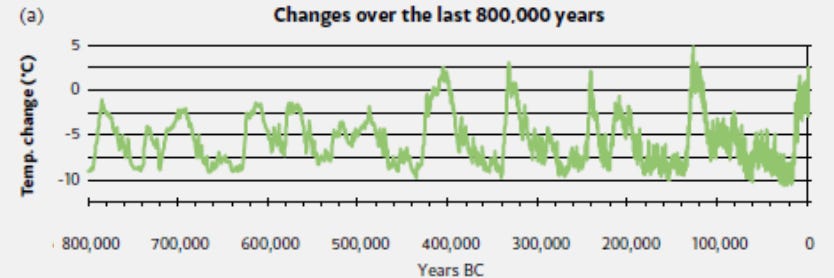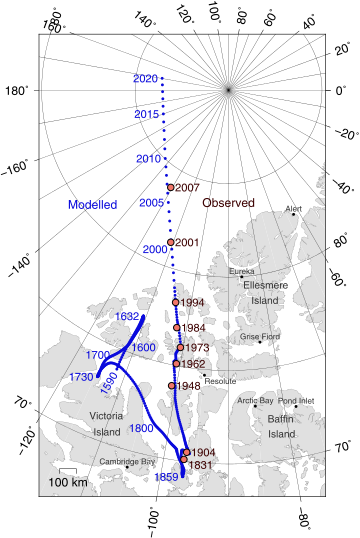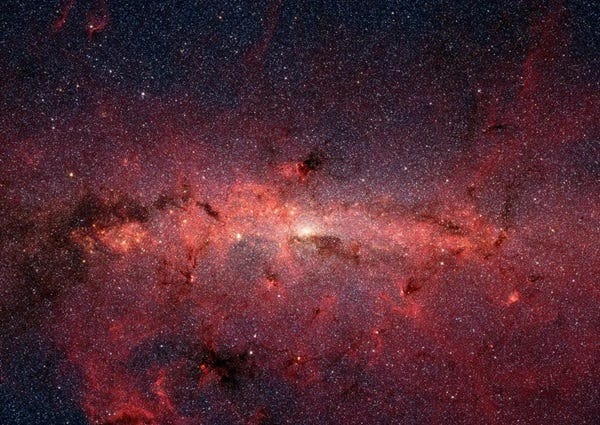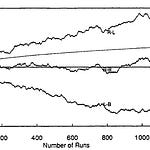There have been, and will be again, many destructions of mankind arising out of many causes; the greatest have been brought about by the agencies of fire and water, and other lesser ones by innumerable other causes. . . . Just when you and other nations are beginning to be provided with letters and the other requisites of civilized life, after the usual interval, the stream from heaven, like a pestilence, comes pouring down, and leaves only those of you who are destitute of letters and education; and so you have to begin all over again like children, and know nothing of what happened in ancient times, either among us or among yourselves.
— Plato, the Timaeus
What we think of as the full “history of human civilization” is just the latest cycle of ascendance in a series. Humanity has flourished during the last 12,000 years — a “brief” period of stability in great, turbulent forces that reign in our sun and beyond.
This is the umbrella theme of Robert Schoch’s book, Forgotten Civilizations — a book which also includes references to a dozen other chapters of occluded science, well-documented experiments and observations that have been set aside by the scientific community because they don’t fit into the prevailing paradigm. The book is an invitation to a dozen research projects, but here I will try to summarize just one theme: cosmoclimatology.
The stormy surface of the sun,
earth’s magnetic field and ionosphere,
the motion of our solar system through interstellar space,
the seething black hole at the center of our galaxy
All these systems can erupt, periodically, in ways that are threatening to life on earth. In the ~2 million year history of hominids, there have been many worldwide calamities of celestial origin and more of geologic origin. The latest of these have destroyed civilizations and our memory of technologies that were once highly developed.
Robert Schoch’s wide-ranging book is a breath of fresh air for people like me who think that the scientific community has been willfully blind to diverse findings that would require a rethinking of established paradigms if they were accepted. I’ll focus here just on Chapters 7 through 9 (of 15). These discuss cosmoclimatology = influence of astronomical systems on the earth’s atmosphere. Our sun and even the galactic core have been subject to periodic disturbances that are associated with extinction-level effects on a living earth.
But first, let’s remember some reasons to take these possibilities seriously on a human time scale.
The Carrington Event of September, 1859 was the result of a solar flare that happened to be pointed toward our planet. At the time, telegraph wires were the only widely-deployed electrical technology. The electrical disturbance caused by particles from the sun blew out telegraph systems and shocked the operators. A comparable event in 2023 could knock out computer systems globally and fry the transformers which are essential to power grids around the world. [Speculation in New Scientist]
From about 1600 to 1800 was a Little Ice Age, with temperatures noticeably colder than anything we recognize in our lifetimes. In Europe and N America, there was a lot more snow, ice lasted longer into the spring, and growing seasons were shorter.
The Egyptian Pyramids were built with technologies that we cannot reproduce in the 21st Century. Hollow stone vessels and core drill holes attest to a capacity to work with hard rock that today’s science cannot support or even explain. A thousand-ton foundation stone in Lebanon is ten times larger than any crane today could lift. [I referenced these and other anomalies in a 2021 article.]
There are extensive, ancient tunnel systems in Europe, South America, and Asia. The best known are at Derinkuyu in Turkey.
There are miles of underground tunnels, living quarters for tens of thousands of people, space for gatherings, for cooking, for keeping livestock, all in 7 layers going down to 85 meters below the surface.
Schoch states the obvious: Such underground cities were not built with hand shovels, and there must have been powerful motivation to move living quarters underground. A natural hypothesis is that before the 12,000-year time frame for which we have historic records, there was a highly developed technological civilization and there were long periods of ultraviolet or cosmic ray or other condition that compelled whole communities to seek refuge underground.
End of the last ice age
The Younger Dryas is the name geologists give to the end of the last ice age. There were two dramatic events, about a thousand years apart, with a return to freezing conditions in between. There are competing theories for the cause of the sudden warming; Schoch believes that the ice age ended with a series of solar storms. One of the pieces of evidence that he cites is vitrification of (human-carved) stone monuments. Vitrification means melting of stone, creating a glass-like consistency on the surface. He has found forts in Scotland, stones on the Giza Plateau and elsewhere in Egypt that show signs of vitrification. He takes this as evidence, (1) that the monuments and the Pyramids themselves are much older than the Egyptian dynasties (~5,000 years) and, in fact, older than the Younger Dryas (~12,000 years); and (2) that there were severe solar outbursts, sending tongues of plasma into space from the sun’s atmosphere, touching down on earth and causing these vitrifications locally. Also part of this story: People lived in underground cities to escape dangerous levels of radiation on the earth. Smaller mammals also were able to burrow underground, but the extinctions of sloths, mammoths, and sabre-tooth tigers during this period occurred because large mammals could not hide underground.
By jp.morteveille - jp.morteveille, Public Domain, https://commons.wikimedia.org/w/index.php?curid=1707170
The solar storms melted glaciers the world over, causing flooding which imprinted mankind’s mythic history, including Noah’s flood, the story of Gilgamesh, Manu and Matsya, and countless indigenous legends.
Schoch talks about the solar cataclysm as causing a die-off of humanity. The most technically advanced groups tended to live near the seacoast, which was suddenly under a hundred meters of water, and their economies were more fragile, depending on trade with distant lands for the essentials of life. Only primitive peoples survived. Thus began a global dark age, from which civilization began to re-emerge only 6,000 years later in the Indus Valley, the Yangtze Valley, the Nile Valley, and the Fertile Crescent of Mesopotamia.
Sunspots, solar storms, and earth’s climate
Sunspot activity is approximately cyclical with a period of 11 years. The sun’s magnetic field varies on a 22-year cycle, reaches a minimum and flipping direction when sunspots are at a maximum. The average 11-year cycle can vary by a year or two. There have been 24+ recorded cycles since sunspots were first tracked in 1755.
Sunspots are magnetic storms on the sun’s surface, unrelated to the energy generation that is occurring at the sun’s core. They appear dark because they are slightly cooler than the average 5800o surface temperature, but sunspots are fringed by areas where temperatures are hotter than 5800o, and indeed the hotter temperatures more than make up for the cooler sunspot temperature. During periods when sunspots are more numerous, the earth is warmer, but it is not because of luminosity from the sunspot fringes. Rather, magnetic storms on the sun send plumes of ionized gas which increase the earth’s high-up magnetic field and deflect cosmic rays. Cosmic rays are an important mechanism for seeding clouds in the lower atmosphere, so fewer cosmic rays lead to lower cloud cover (albedo, reflecting sunlight back into space) and more of the sun’s radiation reaching the earth. [Mackey, 2009]
Reading this chain of reasoning, I am reminded what an MIT colleague told me long ago: computer models of the world’s climate future are woefully inadequate. Atmospheric, oceanic, geological, and astronomical systems interact in more ways than we can model, and some of the key inputs have not yet been quantified.
The sun moves
We think of the sun as motionless at the center of the solar system. 99.8% of the mass of the solar system is in the sun. We may correct this to say that the sun goes around the fixed center of mass of the solar system, which is always a few solar diameters outside the sun. But this is not accurate, either. It is true for two bodies that they orbit stably and predictably about their common center of mass. But for a system of three or more bodies, the motion is complex. It is chaotic in the technical sense of the word: long term prediction is impossible because the motions are too sensitive to tiny variations in the present measurements — the butterfly effect.
In the present case, the sun moves in an epitrochoid, returning near its starting place about every 20 years, but the motion never repeats itself exactly. When the sun is swinging through the smaller circles, the acceleration churns up more motion, and magnetic storms are more likely. At present (2023) we are approaching a sunspot maximum (higher earth temperatures) and finishing a tightly-wound epicycle.
In the short term, up to a few hundred years, we can predict the sun’s motion accurately; but we don’t yet know enough about the effect of the orbit on solar storms or the effect of solar storms on the earth to draw conclusions about the probability of events that might affect us.
100,000 year cycles in earth’s climate
This plot comes from a comprehensive 2016 article, published prominently in Nature, which reconstructs a two million year history of Earth’s average temperature. The source is mostly abundance of 18O in ancient ice cores from glaciers that are that old.
This plot comes from a 2013 document compiled by the Australian Academy of Science, looking at a shorter period of 800,000 years. The methodology is not clearly specified
As you can see from differences in these two graphs, determining the temperature hundreds of thousands of years ago is not an exact science. There are, however, some points of consensus.
There is a cycle of approximately 100,000 years
We are near the high-temperature peak of the latest cycle
These peaks arise suddenly (“suddenly” might mean several thousand years) and they subside more gradually
The amplitude of these cycles is about 10oC. For comparison, global warming since 1900 is only about 1oC.
Most of the time, the earth trends much colder than the climate to which we are accustomed
The cycles of ~100,000 years are apparent, but there is no agreement about the driver behind them. The “norm” is for all of Canada and the northern half of the USA and Europe to be covered in thick sheets of ice that we now associated with the extreme Arctic and Antarctic regions. As recently as 12,000 years ago, New York was under a two-mile thick ice sheet. Hard to imagine, and yet this was “recent” history. Anatomically modern humans have been around for 300,000 years and most of this time has been what we would call an “ice age”.
There is a meme that is driving climate panic: “the earth is hotter than it has been in 100,000 years.” The statement is true, but we can see it in a different context. We are near a cyclic peak in temperature that had nothing to do with humans or CO2 emissions until industrial mining of fossil fuels pushed the temperature up 1 extra degree. The warm temperatures of the last 10,000 years have enabled a remarkable flowering of human civilization, which has only recently become a blight upon the ecosphere. We must expect that the long-term trend is for dramatically colder temperatures, and it is arguable that human activity has already delayed a return to ice age conditions.
More worrisome than the cyclic changes are the extraordinary events, solar outbursts that we don’t know how to predict. The largest recent solar ejection occurred in July, 2012 (as reported by NASA). The event was bigger than Carrington in absolute terms, but it was pointed in a different direction, and missed planet earth. We know little about the causes of the more energetic events, and less about the statistical distribution of their strength and frequency.
Shifting magnetic pole
Compasses have not always pointed north. The earth’s magnetic poles flip every 200,000 to 300,000 years, but the most recent reversal took place 780,000 years ago. This was a time when early hominids were alive; but the entire 300,000 tenure of Homo sapiens in our modern form has not known a pole flip.
A pole flip is preceded by a weakening and then disappearance of the earth’s magnetic field. Without a magnetic field to deflect cosmic rays, radiation levels at the earth’s surface can be dangerously high. Cosmic rays seed clouds, increasing the earth’s albedo and cooling the planet. They would also deplete the ozone layer that protects the earth’s surface from the sun’s UV rays.
The magnetic field of the earth has been weakening in the two centuries for which data have been recorded. The effect seems to be accelerating, and the poles are also drifting in position at an increasing rate. Since 2000, the north magnetic pole has shifted about 1,000 km. From Canada, it has crossed into the Eastern hemisphere, headed for Siberia. There are alarmist books and videos on the web, and there are official assurances from NASA and NOAA. Schoch takes the position that we really don’t understand enough to say definitively whether a pole shift is presently underway. But he quotes extensively from Russian geophysicist-catastrophist Dr Alexey Dmitriev.
“There is a growing probability that we are moving into a rapid temperature instability period similar to the one that took place 12,000 years ago…This high-energy atmospheric phenomena, which was rare in the past, is now becoming more frequent, intense, and changed in its nature…These fundamental processes of change create a demand within all of Earth’s life organisms for new forms of adaptation. The natural development of these new forms may lead to a total global revision of the range of species, and life, on Earth…it is evident that we are faced with a problem of the adaptation of humanity to this new state of the Earth.” — A. Dmitriev
The center of our galaxy
Like most (possibly all) galaxies, our Milky Way sports a black hole at its center. Ours contains the mass of about 4 million stars, and as it swallows up gas and whole stars, it shoots out particle beams which appear to us as cosmic rays. Paul Laviolette has been the foremost advocate of the view that violence at the center of our galaxy, 30,000 light years away, can have major impacts on conditions in our solar system and on the earth’s surface.
Center of the Milky Way, photographed as Saggitarius A
“It is proposed that outbursts of cosmic ray electrons from the Galactic Center penetrate the Galaxy relatively undamped and are able to have a major impact on the Solar System through their ability to vaporize and inject cometary material into the interplanetary environment. It is suggested that one such ‘superwave’, passing through the Solar System toward the end of the last Ice Age, was responsible for producing major changes in the Earth’s climate and for indirectly precipitating the terminal Pleistocene extinction episode.”
Note that this is not inconsistent with Schoch’s hypothesis of solar storms ending the ice age. The superwave from the galactic core can bombard the sun, precipitating solar storms.
LaViolette then goes on to cite evidence for this hypothesis from isotope levels in 12,000-year-old ice cores, as well as astronomical observations. Particle beams from the center of the galaxy have the potential to disrupt our environment in many different ways
Creating comets, increasing risk of meteor impacts
Stimulating the sun to heightened activity, which would warm the earth
Showering Earth with cosmic rays, which would cool the earth
Damaging the ozone layer which protects life on the surface from the sun’s UV
Seeding clouds that cause cooling
Interstellar dust clouds
Our galaxy is a big family of objects, some condensed like planets, stars of various types and black holes; some dispersed like nebulae and clouds of gas and dust. Roughly speaking, we are all in orbit around the galactic center, but every object is on its own path, attracted to whatever happens to be passing by.
At present, our solar system is on the verge of entering a dust cloud located in the direction of the constellation Hercules, traveling at a relative velocity about 20 km per second. The dust is very diffuse, finer than the best vacuums we are able to create on earth; nevertheless, it is tens of thousands of times denser than the surrounding interstellar medium. (The story was first presented 45 years ago by Alfred Vidal-Madjar in the Astrophysical Journal.)
Normally, the interstellar medium is kept out of the solar system by the positive pressure created by discharge from the sun. Even in quiet times, the sun is sending streams of particles out in all directions, the solar wind, which pushes out the interstellar medium somewhere beyond the orbits of Neptune and Pluto.
The collision velocity with the dust cloud is likely to create pressures that can overcome the solar wind. What happens when this dust enters our solar system, traveling at high speed? The most likely effect (according to Jeffrey Winters and (again) Dmitriev and LaViolette) is to bombard the sun, increasing solar activity and warming the earth, while increasing surface UV and cosmic rays to levels that would be unhealthy for life.
Is this a hint about the original purpose of those ancient tunnels and underground cities, found all over the planet (mentioned at the beginning of this article, and described by a German husband-and-wife team)?
Postlude
It is a major theme in evolutionary history that natural selection takes place at a rate faster than geological and ecological changes. This results in species being too-well adapted to whatever specific conditions happen to prevail at the time. Over and over, species have suffered extinction when conditions changed and they were no longer well-adapted. So evolution has found pathways to robustness, insurance against change. For example, our genome contains inactive copies of genes that were useful in the past and retained because they may again be useful some time in the future.
For hundreds of thousands of years, our human culture has been diverse and robust. But presently, capitalism has driven our world toward global integration, complex supply chains for essentials of life, just-in-time delivery schedules, combined with complex, global trade networks. Our world economy is very efficient and very fragile, becoming more so every year. Thinking about our vulnerability to unpredictable cosmic events may help motivate us as a species to step back toward more diversity, more local self-sufficiency, more innovation. The human future may depend upon it.



















Schoch Waves from our Solar System and Beyond